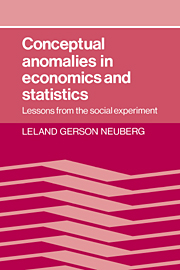Book contents
- Frontmatter
- Contents
- Preface
- Introduction
- PART I STATISTICAL LOGICS
- Chapter 1 J. S. Mill and some philosophical underpinnings of controlled experimentation
- Chapter 2 R. A. Fisher, randomization, and controlled experimentation
- Chapter 3 Some special difficulties of controlled social experiments
- Chapter 4 Hume's problem of induction in modern statistical inference and controlled experimentation
- Summary and conclusion of Part I
- PART II ECONOMIC LOGICS
- Conclusion: Some possible barriers to controlled social experiments as science
- Appendix: Proofs of theorems, lemmas, and propositions
- References
- Symbols and abbreviations
- Index
Chapter 2 - R. A. Fisher, randomization, and controlled experimentation
Published online by Cambridge University Press: 16 February 2010
- Frontmatter
- Contents
- Preface
- Introduction
- PART I STATISTICAL LOGICS
- Chapter 1 J. S. Mill and some philosophical underpinnings of controlled experimentation
- Chapter 2 R. A. Fisher, randomization, and controlled experimentation
- Chapter 3 Some special difficulties of controlled social experiments
- Chapter 4 Hume's problem of induction in modern statistical inference and controlled experimentation
- Summary and conclusion of Part I
- PART II ECONOMIC LOGICS
- Conclusion: Some possible barriers to controlled social experiments as science
- Appendix: Proofs of theorems, lemmas, and propositions
- References
- Symbols and abbreviations
- Index
Summary
Introduction: Fisher and the emergence of the modern approach
Assessing Fisher's historical role
In a 1976 paper on R. A. Fisher's work, the statistician L. Savage remarks: “Fisher is the undisputed creator of the modern field that statisticians call the design of experiments” (1976, p. 450). What does it mean, though, to say that Fisher “created” a field? Work on techniques of agricultural field experimentation began with Bacon in 1627. By the end of the nineteenth century, that work included such modern techniques as matched-pairs designs, use of (at least particular) Latin-square layouts, and replication. And the use of probabilistic methods in astronomical observations began with the work of Legendre (in 1806) and Gauss (in 1809) on the theory of errors. By the end of the nineteenth century, these probabilistic methods included such staples of modern analysis of variance as fixed-effects and variance-components models. Finally, Darwin, in 1859, made the roughly modern notion of variation and variability central to subsequent work in evolutionary biology. By the dawn of the twentieth century there were three independent strands of research (in agriculture, astronomy, and biology), each containing elements of the statistician's modern experimental design.
In the early part of the twentieth century the three independent strands of research began to come together. In 1908, “Student” proposed his t test, worked out some of its probability distributional properties (thus extending the theory of errors), and illustrated its use with a matched-pairs design.
- Type
- Chapter
- Information
- Conceptual Anomalies in Economics and StatisticsLessons from the Social Experiment, pp. 36 - 60Publisher: Cambridge University PressPrint publication year: 1989



